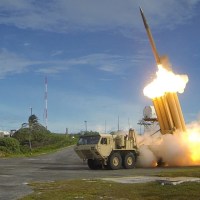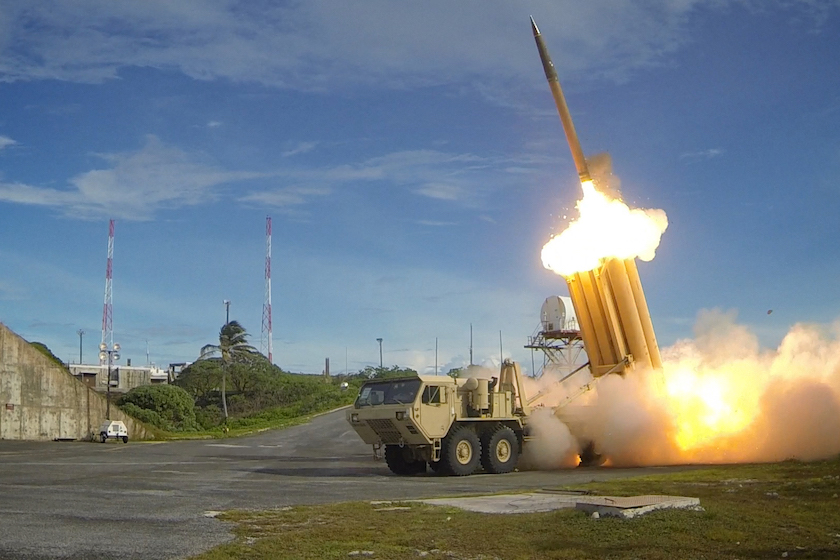Before the 2003 invasion of Iraq, military leaders promised a campaign of “shock and awe” that would deliver swift, decisive victory. Almost 15 years later, we are still dealing with the fallout of war.
Now we’re on the edge an even more perilous conflict in North Korea. This summer, President Trump promised to meet any hostility from North Korea with “fire and fury like the world has never seen.” Since then, the rhetoric has only ratcheted up on both sides.
The stakes are much higher this time than they were in Iraq. North Korea is close to being able to strike the US with a nuclear weapon. Any military confrontation would quickly spiral out of control and cost millions of lives.
To many, the president’s words sound defiant and tough—the only language a dictator like Kim Jong-un can understand. But what we’re really doing is painting North Korea into a corner, making war a foregone conclusion.
We’ve seen it before. We’ve done it before. And North Korea was watching closely.

They were watching when the US and its allies forced Iraq to dismantle its chemical weapons program after the first Gulf War—a program they’d built years earlier with American help. North Korea was watching in 2003 when we used WMDs as a pretext for invading Iraq so we could oust the dictator Saddam Hussein, after he no longer had the ability to defend himself through WMDs.
North Korea was watching when we did the same to Libya, when Muammar Gaddafi’s regime voluntarily gave up its chemical weapons in hopes of rejoining the international community. They were watching as Libya descended into civil war a few years later—and as the Obama administration intervened to ensure Gaddafi’s ouster, after he no longer had the ability to defend himself through WMDs.
President Trump may have raised the stakes in North Korea, but he is operating from the same playbook as his predecessors.
Step one: we portray our enemies as unhinged monsters. Then we demand they act rationally. We impose sanctions that almost always hurt ordinary people more than they hurt the rogue regimes that oppress them. We demand other countries dismantle their weapons or face the full “fire and fury” of our weapons. And even when they comply, there is still no way out—because we’ve already painted them as irrational monsters who cannot be negotiated or reasoned with. We’ve given ourselves a pretext for war, and our enemies a pretext to keep pursuing weapons of mass destruction.
This is madness. There is no way to climb down from this self-fulfilling prophecy, no way to de-escalate.
“North Korea best not make any more threats to the United States. They will be met with fire and fury like the world has never seen.”
– President Donald Trump, August 8, 2017
It would be tempting to assume the president’s words were bluster or calculated exaggeration. But with each day that passes without cooler heads prevailing, it seems more and more likely that President Trump is opening the door to an unprecedented military act: firing our weapons of mass destruction at an enemy before they’ve attacked us. In 15 short years, we’ve gone from a preemptive conventional strike in Iraq to entertaining the prospect of a preemptive nuclear strike in North Korea.
This is the price we pay when we insist on viewing our enemies as irrational monsters, as less than human—when we reduce them to a caricature or a trope. This is what happens when we tell ourselves we’re about to be struck at any moment, and our only option is to strike first.
Violence becomes a foregone conclusion. It becomes a gateway to even more shocking levels of violence. Each escalating act makes it a little easier to rationalize the next one, and the one after that.
In 15 short years, we’ve gone from “strike first” to “annihilate first.”
But ultimately, this is not about the president. It’s not about any one person. It’s about an entire system that doesn’t know—or care—how to de-escalate violence before it’s too late.
We are on a timeline, and that timeline is dragging us inexorably to war. You can hear the drums beating. We’re already marching to them without realizing it. We don’t even know we’re marching in a military parade right now, just like the North Koreans—only more subtle. We may not be wearing medals on our chests or driving tanks down the street, but we are marching to war.

And I’m standing here in the rubble of Iraq and Syria, where lives are still being unmade by the cycle of violence that began decades ago—and I am telling you that I have seen this before. I know where this is going. I know where it ends.

I’ve seen the dead bodies on the street. I’ve seen whole cities destroyed. I’ve seen mothers who’ve had everything they love ripped from their arms. My friends have had flesh burned and their bodies embedded with furious, fiery shrapnel.
This is not a partisan moment. This is not about whether you are pro-Trump or anti-Trump. This is not about coddling dictators or tyrannical regimes. This is about one and only one thing: whether or not we are truly “pro-life.”
Millions of North Koreans have suffered under their regime. Millions would suffer—and possibly die—in a “fire and fury” strike. The loss of life will be catastrophic on the other side of Demilitarized Zone, too. Nearly half of South Korea’s population—25 million people—live within 50 miles of the DMZ, in easy range of North Korean missiles. Tens of thousands would be killed within the first hours of a retaliatory strike by North Korea. Iraq War veteran and conservative columnist David French gamed out a chillingly plausible scenario for how war with North Korea might unfold. President Trump’s own Secretary of Defense has said this would likely be “the worst kind of fighting in most people’s lifetimes.”

Even if violence is sometimes necessary as a last resort, it is never a solution. When we respond to each provocation with an escalating counter-provocation, our enemies become what we imagine them to be. We give them—and ourselves—no other way out.
Violence breeds violence. Just as “shock and awe” fueled the rise of the insurgency in Iraq, which led to the infamous US surge, which had the appearance of victory… until the insurgents resurfaced a few years later under the banner of ISIS.
And on it goes.
There are no easy answers. At some point, somebody has to say “enough!” Someone has to decide that it’s better to risk your life in order to love your enemy than to take someone else’s life in order to defeat your enemy.
If we, as individuals, cannot bring ourselves to love our enemies, the least we can do is commit to not treating them as irrational monsters who are utterly incapable of thinking and reasoning in their own self-interest. Loving our enemies can start by allowing that men like Saddam Hussein, Muammar Gaddafi, and Kim Jong-un (and maybe our leaders as well) all seek to act in ways that are rationally consistent with their view of themselves, their people, their nations, and the world around them. Such an acknowledgment is not weak moral equivalence. And it does not mean we should accept their actions or let their provocations go unchallenged. But it’s the only reasonable starting point for building an effective strategy to respond.
War is not yet our only option. But if that’s where this is going, every one of us must be ready to show up on the frontlines of conflict, to stand in the fallout for those whose lives will be burned by war.
If we’re not prepared to do that, now is the time to speak out.


